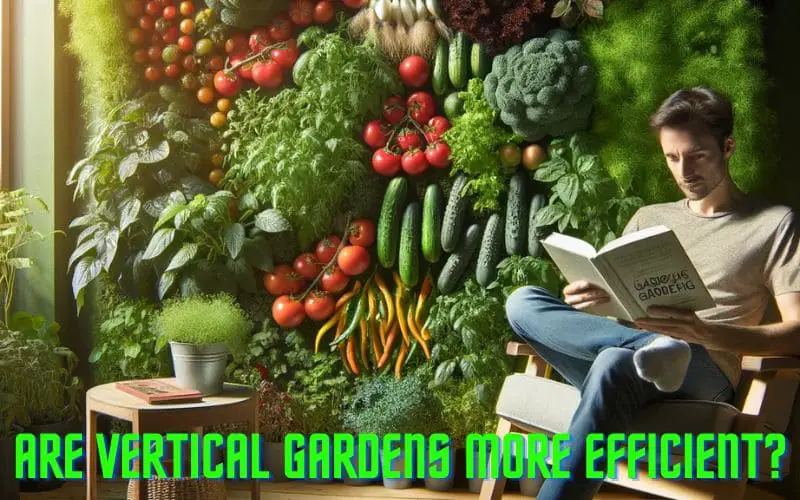Are Vertical Gardens More Efficient? We Discover The Answer!

Introduction
Welcome to our comprehensive exploration of vertical gardens, a revolutionary approach to soilless agriculture that maximizes plant growth in minimal spaces. In this article, we will delve into the concept of vertical gardens and analyze their efficiency compared to traditional gardens. We’ll also explore successful implementations and applications of vertical gardens in urban and residential environments.
What are Vertical Gardens?
Definition and Concept
Vertical gardens, also known as living walls or green walls, are innovative gardening systems that involve growing plants vertically, usually on a wall or similar vertical structure. These gardens utilize specialized containers, hydroponic or aeroponic systems, and carefully selected plants to create stunning greenery in limited spaces.
Benefits of Vertical Gardens
Vertical gardens offer a range of benefits, including improved air quality, insulation, and aesthetic appeal. They also contribute to biodiversity, energy efficiency, and urban heat island mitigation. Moreover, vertical gardens can serve as efficient space-saving solutions, making them ideal for urban environments and residential settings.
Types of Vertical Gardens
- Hydroponic Vertical Gardens: This type of vertical garden utilizes a nutrient-rich water solution to grow plants, eliminating the need for soil. It is an efficient and space-saving method of vertical gardening, ideal for indoor and urban environments. Hydroponic systems often incorporate automatic irrigation and nutrient delivery systems for optimal plant growth.
- Modular Green Wall Systems: These systems consist of modular panels that can be easily mounted on walls or freestanding structures. They provide a versatile platform for creating customized living walls, allowing for varying plant densities and species. Modular green wall systems are designed for both aesthetic appeal and environmental benefits, such as improved air quality and insulation.
- Pocket Vertical Gardens: This type of vertical garden features small pockets or cells for planting individual plants. It offers a creative and visually appealing way to adorn vertical surfaces with vibrant plant life. Pocket gardens are popular for their adaptability and suitability for both indoor and outdoor settings.
- DIY Vertical Garden Projects: Individuals can design and create their own vertical gardens using innovative and sustainable materials. This type of vertical gardening encourages creativity and resourcefulness, allowing for unique designs and personalization. DIY projects often promote a deeper connection with nature and the environment.
Are Vertical Gardens More Efficient?
Comparison with Traditional Gardens
When comparing vertical gardens to traditional horizontal gardens, the efficiency of vertical gardens becomes evident. Vertical gardens optimize land use, allowing for increased plant density in limited spaces. Additionally, they require less water and maintenance while offering excellent air purification and insulation benefits.
Environmental Impact
Vertical gardens have a significant and positive impact on the environment, especially in urban areas. These gardens play a crucial role in addressing urban environmental challenges through their ability to mitigate the urban heat island effect, reduce air pollution, and promote biodiversity. Let’s explore in more detail:
- Urban Heat Island Effect: Vertical gardens help to counteract the urban heat island effect by providing natural cooling effects. The plant-covered structures absorb solar radiation and release moisture through transpiration, lowering ambient temperatures in urban areas.
- Air Pollution Reduction: The presence of vertical gardens in urban settings leads to a decrease in air pollution. Plants filter out harmful pollutants and particulate matter, thereby enhancing air quality and contributing to the overall well-being of city residents.
- Biodiversity Promotion: Vertical gardens serve as habitats for various forms of urban wildlife, including insects, birds, and microorganisms. This diverse ecosystem contributes to the preservation and enhancement of urban biodiversity, creating a more harmonious coexistence between nature and the built environment.
- Sustainable Cityscapes: By integrating greenery into vertical structures, cities can develop more sustainable and visually appealing urban landscapes. This blend of nature and architecture enhances the aesthetic value of the city while supporting the principles of sustainability and environmental conservation.
Productivity and Yield
In terms of productivity and yield, vertical gardens offer impressive results. With efficient hydroponic or aeroponic systems, these gardens can support the growth of various plants, including vegetables, herbs, and ornamentals. Their space-saving design and high adaptability make them valuable additions to urban farming initiatives.
Examples of Successful Implementation
Urban Environments
In urban environments, vertical gardens are employed in diverse applications, such as green facades on buildings, urban agriculture projects, public space enhancements, and interior design elements. These applications not only contribute to environmental sustainability and urban greening but also offer numerous social, economic, and health-related benefits to the communities.
Vertical gardens in urban environments have evolved to address various urban challenges and enhance the quality of urban life. The following points outline the expanded relevance of vertical gardens in urban settings:
- Environmental Impact: Vertical gardens play a crucial role in mitigating the urban heat island effect, improving air quality, reducing noise pollution, and conserving energy in buildings.
- Community Engagement: These green installations encourage community engagement, fostering a sense of ownership, pride, and stewardship among residents and businesses.
- Renewable Resources: Vertical gardens can act as a source of renewable resources through urban agriculture, promoting self-sufficiency and food security in urban areas.
- Well-being and Mental Health: The presence of greenery positively impacts mental health and well-being, offering a respite from the hustle and bustle of urban life.
Residential Applications
Vertical gardens are revolutionizing the way homeowners interact with green spaces within residential settings. By incorporating vertical gardens, homeowners can transform confined areas, balconies, and interior spaces into lush, thriving landscapes. These verdant installations not only serve as a stunning visual focal point but also provide numerous benefits to residents and their living spaces.
- Enhanced Aesthetics: Vertical gardens offer a visually striking addition to residential properties, elevating the overall appeal and charm of the space.
- Improved Air Quality: The abundance of foliage in vertical gardens acts as a natural air purifier, contributing to a healthier indoor environment.
- Space Optimization: For urban dwellers with limited outdoor space, vertical gardens provide an innovative solution for integrating greenery into their homes.
- Biophilic Connection: The presence of greenery in residential environments fosters a deep connection with nature, promoting a sense of tranquility and well-being.
Conclusion
In conclusion, vertical gardens present an innovative approach to sustainable and efficient gardening in both urban and residential settings. Their space-saving design, environmental benefits, and impressive productivity make them valuable assets in the realm of soilless agriculture and urban greening initiatives. By embracing vertical gardens, individuals and communities can contribute to a greener, healthier, and more vibrant living environment.
